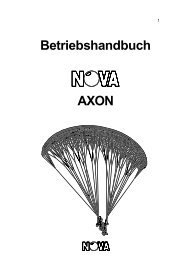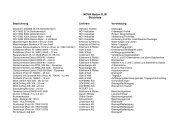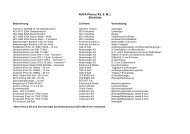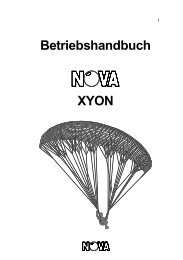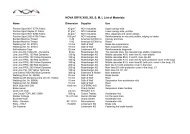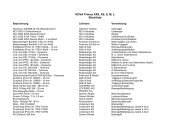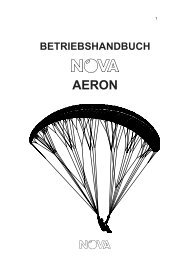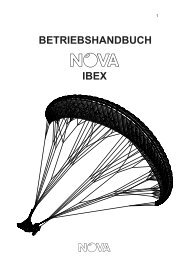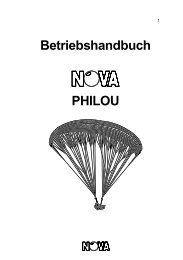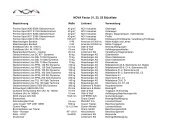Version 1.0 01/06/2011 - Nova Paragliding
Version 1.0 01/06/2011 - Nova Paragliding
Version 1.0 01/06/2011 - Nova Paragliding
You also want an ePaper? Increase the reach of your titles
YUMPU automatically turns print PDFs into web optimized ePapers that Google loves.
C-Stall<br />
This manoeuvre can be found sporadically in some paragliding literature. We<br />
don’t recommend it, because entering and exiting the C-stall can be very<br />
demanding and dangerous for many pilots.<br />
Collapses<br />
Asymmetric collapse<br />
If you fly in strong turbulences, one side of the glider might collapse. This<br />
happens if one side of the wing doesn’t produce lift anymore, due to a low<br />
angle of attack. If there is no lift, the lines get loose and the wing deforms or<br />
collapses.<br />
Most of these collapses are rather small – they only affect a small part of the<br />
wingspan. In such a case, the FACTOR 2 continues to fly almost unaffected. If<br />
the collapse affects 50% of the wingspan or more, the wing will react<br />
considerably:<br />
Due to the increased drag of the collapsed wing, the glider will turn to the<br />
collapsed side. Furthermore, the glider will pitch down because of the increased<br />
wing loading. (The glider has to increase its speed because of the reduced area<br />
– that’s what causes the pitching down.)<br />
The pilot can prevent the glider from pitching and turning, by applying the<br />
brake on the non collapsed side of the wing. If a collapse occurs close to the<br />
ground it is essential to react properly. The proper reaction should be taught at<br />
high altitude, ideally under professional guidance.<br />
As explained above, most of the collapses can be prevented, if you fly actively!<br />
Front tuck<br />
A front tuck occurs, if the angle of attack gets too low on the whole wingspan,<br />
then the whole leading edge will collapse. After the asymmetric tuck, the<br />
FACTOR 2 will go back to normal flight automatically. The pilot can expedite<br />
the opening process by slightly applying both brakes.<br />
Vers.<strong>1.0</strong><br />
0<strong>1.0</strong>6.2<strong>01</strong>1 S. 17 / 39



